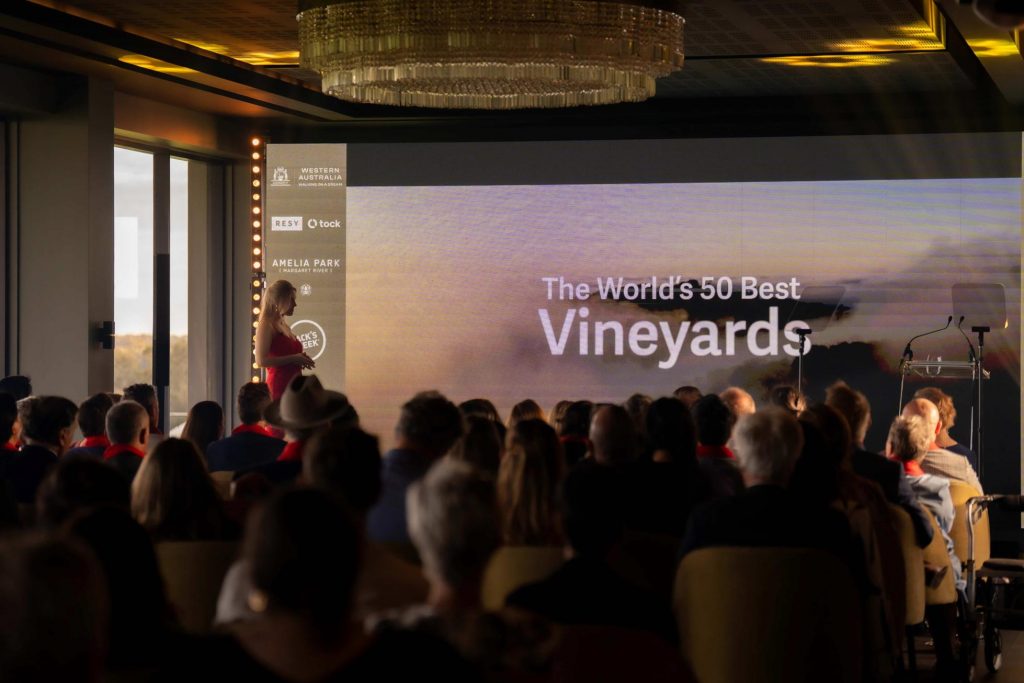Vik, a wine property in Chile’s Millahue Valley, rose from second place to claim the No. 1 position in The World’s 50 Best Vineyards 2025, announced Nov. 19 at a ceremony in Margaret River, Western Australia. The win caps a strong showing for South American wine regions, with Chile securing six spots and Argentina seven on the annual list compiled by media company William Reed.
The rankings, which joined the 50 Best brand portfolio this year alongside The World’s 50 Best Restaurants, Bars and Hotels, assess wine tourism destinations based on visitor experience rather than wine quality alone. More than 700 wine and travel experts from across 22 geographic regions submitted nominations for vineyards they had personally visited.
“We are thrilled to announce The World’s 50 Best Vineyards 2025 list and honor Vik as The World’s Best Vineyard,” said William Drew, director of content for The World’s 50 Best Vineyards, in a release. “The estate has shown exceptional dedication to creating immersive vineyard experiences, seamlessly blending innovative design within the stunning Millahue Valley landscape.”
South America’s Strategic Advantage
The Vik estate spans 4,400 hectares, which the indigenous Mapuche people called the “golden place” for winemaking. Founded in 2004, the property now features futuristic architecture, 22 individually styled guest suites and wines produced across multiple distinct microclimates. The winery succeeds 2024 winner Bodegas de los Herederos del Marqués de Riscal in Rioja, Spain, which now enters the Hall of Fame.
Chile’s other entries demonstrate varied approaches to wine tourism. Montes at No. 10 in Colchagua Valley offers cellar tastings accompanied by Gregorian chants and a 6-kilometer botanic hiking trail. Rothschild-owned Almaviva (No. 34) brings Bordeaux château traditions to Maipo Valley with contemporary elegance. Viña Santa Rita (No. 41) transports visitors by horse-drawn carriage or pedal-powered bar wagon across its 40-hectare estate, which includes a museum and neo-Gothic chapel.
Uruguay’s Bodega Garzón at No. 4 represents another South American wine tourism success. The winery opened only in 2016 but features acclaimed chef Francis Mallmann’s open-fire cooking in a 120-seat restaurant, demonstrating how newer estates can compete immediately with established properties through comprehensive visitor experiences.
Argentina’s seven entries emphasize the country’s dramatic geography. Bodega Colomé (No. 30) operates at 3,111 meters above sea level in the Andes. Bodegas Salentein (No. 12) conducts tastings around a two-ton limestone conference table in gravity-fed cellars. Durigutti Family Winemakers (No. 11) offers helicopter vineyard tours, sampling natural and organic wines while flying over mountain ranges.
European Heritage Continues
Germany’s Schloss Johannisberg claimed the No. 2 and the Best Vineyard in Europe titles. The estate began producing wine in 817 CE and became the world’s first dedicated Riesling vineyard in 1720. Visitors tour 900-year-old abbey vaults containing more than 25,000 bottles.
French champagne houses also demonstrated staying power. Maison Ruinart (No. 8), founded in 1729, offers tours through eight kilometers of chalk cellars. Champagne Bollinger (No. 15), established in 1829, claims the region’s largest barrel collection with more than 4,000 oak casks. Château d’Yquem (No. 9) opened its Sauternes estate to public tours only in 2016 after centuries of private operations.
Spain placed seven wineries, second only to Chile. Bodegas Ysios (No. 3) features avant-garde architecture against Sierra de Cantabria mountains. Vivanco (No. 24) operates a 4,000-square-meter Museum of Wine Culture. Bodegas Tio Pepe (No. 21) immerses visitors in sherry production within Jerez’s Old Town, offering accommodation in renovated 19th-century worker cottages.
South Africa’s Klein Constantia (No. 6) won both The Best Vineyard in Africa and the Highest Climber Award after jumping 35 places from 2024. The 1685 estate pairs Cape Dutch architecture with modern amenities, including open-top Land Rover vineyard tours and cellar experiences.
North American Diversity
California’s Jordan Vineyard & Winery (No. 13) claimed The Best Vineyard in North America title for its 485-hectare Sonoma County estate founded in 1972. Aperture Cellars (No. 14) earned the Highest New Entry Award for its Sonoma debut, where winemaker Jesse Katz created three distinct tasting experiences.
Properties from other North American regions also gained recognition. Texas Hill Country’s William Chris Vineyards (No. 31) offers southern hospitality among 400-year-old oak groves north of San Antonio. Oregon’s Willamette Valley contributed two biodynamic estates: Brooks Wine (No. 35) earned B Corp certification in 2019, while Maysara Winery (No. 23) operates under Zoroastrian philosophy emphasizing ecological harmony.
Global Representation
English sparkling wine secured two entries. Nyetimber (No. 32) has driven sector growth since 1988, offering chef-paired dinners on South Downs grounds. Gusbourne (No. 28) planted its first vines in 2004, intending to compete with European sparkling wines.
Japan’s 98Wines (No. 20) repeated as The Best Vineyard in Asia. Winemaker Yuki Hirayama returned from Burgundy training in 2019 to produce Koshu and Muscat Bailey wines with Mount Fuji views.
New Zealand’s Cloudy Bay Vineyards (No. 26) earned The Best Vineyard in Australasia, offering tours by four-wheel drive or helicopter, culminating in private yacht cruises into the Marlborough Sounds. Lebanon’s Château Héritage (No. 33) represents Middle Eastern wine tourism near the historic Temple of Bacchus.
“This year’s list highlights the diversity and innovation of the vineyards shaping the global wine scene,” Drew said. “It is a celebration of excellence, passion and the stories behind each vineyard, and we look forward to wine lovers around the world discovering these remarkable places.”

